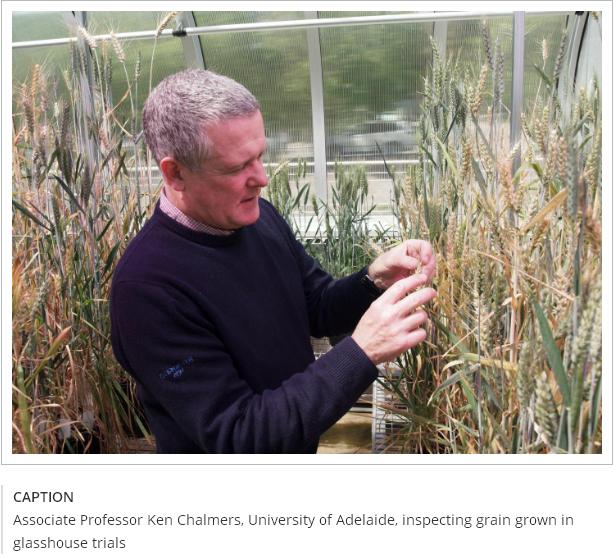博文
大、小麦基因组研究有助世界粮食高产,缓解供需矛盾
||
大、小麦基因组研究有助世界粮食高产,缓解供需矛盾
诸平
据澳大利亚阿德莱德大学 (University of Adelaide)2020年11月25日提供的消息,面对世界人口增长,耕地面积减少,粮食供需矛盾日趋严重的局面。科学家们已经发现了小麦和大麦的新遗传变异,这极大地推动了全球育种高产小麦和大麦品种的努力。
一项国际合作研究,包括来自澳大利亚、德国、美国、中国、日本、英国以及加拿大的科学家已经解开了小麦和大麦的新基因变异之谜,这极大地推动了全球高产小麦和大麦品种的育种工作。
除了澳大利亚阿德莱德大学怀特研究所(University of Adelaide's Waite Research Institute)的科学家,还有来自澳大利亚默多克大学(Murdoch University)、澳大利亚第一产业和区域发展部(Department of Primary Industries and Regional Development, Australia);德国莱布尼茨植物遗传和作物植物研究所(Leibniz Institute of Plant Genetics and Crop Plant Research (IPK) Gatersleben)、德国环境健康研究中心慕尼黑亥姆霍兹中心的植物基因组与系统生物学(Plant Genome and Systems Biology, Helmholtz Center Munich, German Research Center for Environmental Health)、德国慕尼黑理工大学(Technical University of Munich)、德国综合生物多样性研究中心(German Centre for Integrative Biodiversity Research (iDiv) Halle-Jena-Leipzig)、德国哥廷根大学综合育种研究中心(Center for Integrated Breeding Research, Georg-August-University Göttingen);美国哈德森阿尔法生物技术研究所(HudsonAlpha, Institute for Biotechnology)、美国蒙大拿生物农业公司(Montana BioAgriculture Inc.);中国农业科学院作物科学研究所(Institute of Crop Sciences, Chinese Academy of Agricultural Sciences)、浙江大学农业与生物技术学院(College of Agriculture and Biotechnology, Zhejiang University)、长江大学湖北省粮食产业协同创新中心(Hubei Collaborative Innovation Centre for Grain Industry, Yangtze University);日本理化研究所可持续资源科学中心生物生产力信息学研究小组(Bioproductivity Informatics Research Team, RIKEN Center for Sustainable Resource Science, Japan)、日本横滨市立大学(Yokohama City University)、日本冈山大学(Okayama University);英国詹姆斯·哈顿研究所(The James Hutton Institute)、英国邓迪大学(University of Dundee);加拿大萨斯喀彻温大学(University of Saskatchewan)的科学家也参与此项研究。
来自加拿大萨斯喀彻温大学(University of Saskatchewan)的Curtis Pozniak教授领导的10+小麦基因组计划(10+ Wheat Genomes Project)的研究人员,以及由德国莱布尼兹植物遗传与作物植物研究所(Leibniz Institute of Plant Genetics and Crop Plant Research, IPK)尼尔斯·斯坦因教授(Professor Nils Stein)领导的国际大麦泛基因组测序联盟(International Barley Pan Genome Sequencing Consortium)的研究人员,已经对这两种谷物的一组基因组进行了测序,研究结果于2020年11月25日已经在《自然》(Nature)杂志网站上发表-——Murukarthick Jayakodi, Sudharsan Padmarasu, Georg Haberer, Venkata Suresh Bonthala, Heidrun Gundlach, Cécile Monat, Thomas Lux, Nadia Kamal, Daniel Lang, Axel Himmelbach, Jennifer Ens, Xiao-Qi Zhang, Tefera T. Angessa, Gaofeng Zhou, Cong Tan, Camilla Hill, Penghao Wang, Miriam Schreiber, Lori B. Boston, Christopher Plott, Jerry Jenkins, Yu Guo, Anne Fiebig, Hikmet Budak, Dongdong Xu, Jing Zhang, Chunchao Wang, Jane Grimwood, Jeremy Schmutz, Ganggang Guo, Guoping Zhang, Keiichi Mochida, Takashi Hirayama, Kazuhiro Sato, Kenneth J. Chalmers, Peter Langridge, Robbie Waugh, Curtis J. Pozniak, Uwe Scholz, Klaus F. X. Mayer, Manuel Spannagl, Chengdao Li, Martin Mascher, Nils Stein. The barley pan-genome reveals the hidden legacy of mutation breeding. Nature, 2020; Published: 25 November 2020. DOI: 10.1038/s41586-020-2947-8
Sean Walkowiak, Liangliang Gao, Cecile Monat, Georg Haberer, Mulualem T. Kassa, Jemima Brinton, Ricardo H. Ramirez-Gonzalez, Markus C. Kolodziej, Emily Delorean, Dinushika Thambugala, Valentyna Klymiuk, Brook Byrns, Heidrun Gundlach, Venkat Bandi, Jorge Nunez Siri, Kirby Nilsen, Catharine Aquino, Axel Himmelbach, Dario Copetti, Tomohiro Ban, Luca Venturini, Michael Bevan, Bernardo Clavijo, Dal-Hoe Koo, Jennifer Ens, Krystalee Wiebe, Amidou N’Diaye, Allen K. Fritz, Carl Gutwin, Anne Fiebig, Christine Fosker, Bin Xiao Fu, Gonzalo Garcia Accinelli, Keith A. Gardner, Nick Fradgley, Juan Gutierrez-Gonzalez, Gwyneth Halstead-Nussloch, Masaomi Hatakeyama, Chu Shin Koh, Jasline Deek, Alejandro C. Costamagna, Pierre Fobert, Darren Heavens, Hiroyuki Kanamori, Kanako Kawaura, Fuminori Kobayashi, Ksenia Krasileva, Tony Kuo, Neil McKenzie, Kazuki Murata, Yusuke Nabeka, Timothy Paape, Sudharsan Padmarasu, Lawrence Percival-Alwyn, Sateesh Kagale, Uwe Scholz, Jun Sese, Philomin Juliana, Ravi Singh, Rie Shimizu-Inatsugi, David Swarbreck, James Cockram, Hikmet Budak, Toshiaki Tameshige, Tsuyoshi Tanaka, Hiroyuki Tsuji, Jonathan Wright, Jianzhong Wu, Burkhard Steuernagel, Ian Small, Sylvie Cloutier, Gabriel Keeble-Gagnère, Gary Muehlbauer, Josquin Tibbets, Shuhei Nasuda, Joanna Melonek, Pierre J. Hucl, Andrew G. Sharpe, Matthew Clark, Erik Legg, Arvind Bharti, Peter Langridge, Anthony Hall, Cristobal Uauy, Martin Mascher, Simon G. Krattinger, Hirokazu Handa, Kentaro K. Shimizu, Assaf Distelfeld, Ken Chalmers, Beat Keller, Klaus F. X. Mayer, Jesse Poland, Nils Stein, Curt A. McCartney, Manuel Spannagl, Thomas Wicker, Curtis J. Pozniak. Multiple wheat genomes reveal global variation in modern breeding. Nature, 2020; Published: 25 November 2020. DOI: 10.1038/s41586-020-2961-x. 据研究者自述,他们的研究结果将为下一代小麦和大麦新品种打开了大门。
阿德莱德大学(University of Adelaide)副教授肯·查尔默斯(Ken Chalmers)以及他的农业、食品和葡萄酒学院(School of Agriculture, Food & Wine)的同事、名誉教授彼得·兰格里奇(Peter Langridge)一起领导阿德莱德大学的研究。彼得·兰格里奇教授说:“小麦和大麦是全世界主要粮食作物,但其产量需要急剧增加,以满足未来的粮食需求。”“据估计,到2050年,仅小麦产量就必须比当前水平增长50%以上,以养活不断增长的全球人口。” 默多克大学的李成道教授(Professor Chengdao Li at Murdoch University)在大麦测序的澳大利亚部分中也发挥了关键作用。
2020年11月25日发表的研究成果使科学家们更接近于解开小麦和大麦的整个基因组或泛基因组之谜。通过了解这些谷物中遗传变异的全部范围,研究人员和植物育种者将拥有实现所需的全球增产所需的必要工具。
彼得·兰格里奇教授说:“基因组学的进步促进了育种,包括水稻和玉米在内的农作物的产量和质量也有所提高,但小麦和大麦的类似努力更具挑战性。” “这主要是由于其基因组的大小和复杂性,我们对控制产量的关键基因的了解有限以及缺乏育种者感兴趣的多系的基因组装配数据。
“现代的小麦和大麦品种具有广泛的基因变异和多样的基因组结构,这些结构与重要特征有关,例如增产,耐旱和抗病性强。
“这种变异不能用单个基因组序列捕获。只有对多个不同的基因组进行测序,我们才能开始了解整个遗传变异的泛基因组。” 这两个国际项目对世界各地的多个小麦和大麦品种进行了测序。阿德莱德部分得到谷物研究与开发公司(Grains Research and Development Corporation,GRDC)的支持。
肯·查尔默斯(Ken Chalmers)副教授说:“通过这些合作项目获得的信息,揭示了这些重要农作物的基因组结构的动态变化和以前隐藏的遗传变异,并显示了育种者如何实现生产力的重大提高。这项工作将支持下一代现代品种的培育和应用。”
包含两个澳大利亚小麦品种AGT-Mace(PBR)和Longreach-Lancer(PBR),反映了澳大利亚南部和北部不同种植区,这意味着可以识别出适应我们不同生产环境的潜在遗传变异。
阿德莱德大学还对3个大麦品种进行了测序,这些大麦品种具有良好的性状,例如高产、并且具有耐高温、耐霜冻、耐盐碱和耐旱以及新的抗病性的潜力。
肯·查尔默斯(Ken Chalmers)副教授说:“这些基因组组装将推动功能基因的发现,并为研究人员和育种人员配备带来下一代现代小麦和大麦栽培品种所需的工具,这些品种将有助于满足未来的食品需求。”更多信息请注意浏览原文或者相关报道。
Genetic diversity is key to crop improvement. Owing to pervasive genomic structural variation, a single reference genome assembly cannot capture the full complement of sequence diversity of a crop species (known as the ‘pan-genome’1). Multiple high-quality sequence assemblies are an indispensable component of a pan-genome infrastructure. Barley (Hordeum vulgare L.) is an important cereal crop with a long history of cultivation that is adapted to a wide range of agro-climatic conditions2. Here we report the construction of chromosome-scale sequence assemblies for the genotypes of 20 varieties of barley—comprising landraces, cultivars and a wild barley—that were selected as representatives of global barley diversity. We catalogued genomic presence/absence variants and explored the use of structural variants for quantitative genetic analysis through whole-genome shotgun sequencing of 300 gene bank accessions. We discovered abundant large inversion polymorphisms and analysed in detail two inversions that are frequently found in current elite barley germplasm; one is probably the product of mutation breeding and the other is tightly linked to a locus that is involved in the expansion of geographical range. This first-generation barley pan-genome makes previously hidden genetic variation accessible to genetic studies and breeding.
Advances in genomics have expedited the improvement of several agriculturally important crops but similar efforts in wheat (Triticum spp.) have been more challenging. This is largely owing to the size and complexity of the wheat genome1, and the lack of genome-assembly data for multiple wheat lines2,3. Here we generated ten chromosome pseudomolecule and five scaffold assemblies of hexaploid wheat to explore the genomic diversity among wheat lines from global breeding programs. Comparative analysis revealed extensive structural rearrangements, introgressions from wild relatives and differences in gene content resulting from complex breeding histories aimed at improving adaptation to diverse environments, grain yield and quality, and resistance to stresses4,5. We provide examples outlining the utility of these genomes, including a detailed multi-genome-derived nucleotide-binding leucine-rich repeat protein repertoire involved in disease resistance and the characterization of Sm16, a gene associated with insect resistance. These genome assemblies will provide a basis for functional gene discovery and breeding to deliver the next generation of modern wheat cultivars.
https://wap.sciencenet.cn/blog-212210-1260385.html
上一篇:常用抗生素有望抵抗寨卡病毒感染
下一篇:发现长期记忆的分子机制
